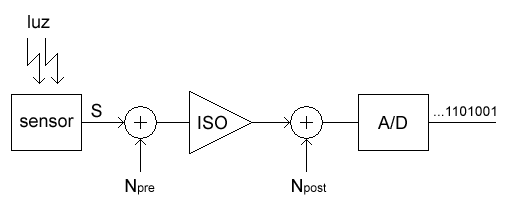So here is where I’m unclear about what’s going on under the hood. The exposure is identical in terms of aperture and shutter. ISO is higher. We expect doing so would make it appear brighter. What I would like explained further (for the non scientist) is how and why? The same amount of light (photons) strike the sensor. What is the ISO doing here to provide a better S/N ratio reducing the noise?
Andrew look at this simple model of your camera's capture pipeline:

Think of 2 sources of noise added to the useful signal (S): Npre and Npost. Npre is added
before ISO amplification, Npost is added
after ISO amplification. ISO amplification by itself doesn't alter the SNR, so the ISO amplification does't improve output SNR with respect to Npre. However with Npost the story changes, and the higher the ISO amplification is, we have higher useful signal vs Npost, so we are improving final SNR with respect to Npost.
In the real world, Npre would be basically the photon noise (inherent to light capture) plus the read noise (electronic noise) produced in the early stages, prior to ISO amplification. Npost would be the read noise produced after the ISO amplification, i.e. in the AD converter.
Hence on those cameras where a big portion of the total noise is added
after the ISO amplification (Canons), the higher the ISO the higher the ouput SNR is for a given amount of photons reaching the sensor. Cameras with a very low read noise (and this consequently means very low Npost) hardly benefit from pushing ISO (Pentax K5, Nikon D7000). Rest of Nikons tend to be in the middle point, but definitively still worth pushing ISO on them like in the Canons.
Canon 350D (both captures at the same shutter/aperture, final exposure matched in pp):

(this image must have been linked in LL more than 10 times

).
Regards